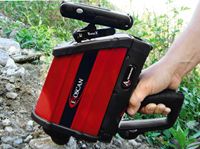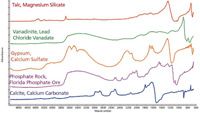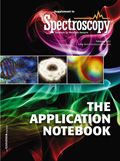Hand-Held FTIR Analyzers — A New Capability for At-Site Measurements of Rock and Minerals — Use of FTIR for Elucidating Rock and Mineral Composition
A2 Technologies' Exoscan hand-held FTIR (Figure 1) is increasingly being used by researchers involved in the geosciences for analysis of rocks, minerals, and soil for a broad variety of applications.
Alan Rein and Frank Higgins, A2 Technologies
A2 Technologies' Exoscan hand-held FTIR (Figure 1) is increasingly being used by researchers involved in the geosciences for analysis of rocks, minerals, and soil for a broad variety of applications. The reason for this acceptance is that the Exoscan system, equipped with diffuse reflectance sampling interface, can be used equally effectively in the laboratory or field locales to provide molecular analysis of geological specimens, with little or no sample preparation.

Figure 1: Field ready hand-held FTIR.
FTIR is a natural complement to the X-ray fluorescence (XRF) field analyzers that have been used for years by geoscientists. Whereas the latter analyzers provide information about what elements are present, FTIR provides information about how the elements are bonded to form the mineral's chemical composition. FTIR is highly sensitive to most minerals composed of light elements, including all silicates which compose 90% of the earth's crust. XRF is more sensitive to the heavier elements. Thus, by using both XRF and FTIR, the geoscientist has a far more complete understanding of the chemistry of the specimen or site.
Mid IR Spectroscopy of Rocks and Minerals
FTIR spectroscopy provides information on covalently bonded molecules and therefore a wide variety of rocks and minerals can be analyzed by this technique. The diffuse reflectance spectra of a variety of mineral classes are shown in Figure 2, which include talc (magnesium silicate), vanadinite (lead chloride vanadate), gypsum (calcium sulfate dihydrate), phosphate rock (Florida phosphate ore), and calcite (calcium carbonate). The spectra are all unique and indicate the characteristic "fingerprint" functional groups which are evident in the spectra, such as gypsum with the SO4 asymmetric stretch at 1140 cm-1 and its first overtone at 2240 cm-1 (broad). Though diffuse reflectance IR spectra look different from classical absorbance spectra, the spectra are reproducible and the mineral can readily be identified from A2's Diffuse Reflectance FTIR Library of Rocks and Minerals.

Figure 1: Field ready hand-held FTIR.
Diffuse Reflectance FTIR Library of Rocks and Minerals
There are a number of FTIR libraries available that contain the absorbance spectra of geological samples recorded by grinding or mixing a small amount of the specimen in KBr or nujol. The complement to an at-site IR analyzer is the ability to record a spectrum with little or no sample preparation via diffuse reflectance IR spectroscopy. This allows the IR spectrum to be obtained, whether the sample area of interest is in an outcrop, ore body, drill core, or inside a mine. Since diffuse reflectance spectra of neat rocks, minerals, and soil differ from absorbance spectra, A2 is developing a unique library for this type of analysis method. Included in the library are general world-wide rocks and minerals as well as minerals that are considered industrially or strategically important.
Rocks and minerals included in the library include nitrates, sulfates, oxides, silicates, aluminosilicates, phosphates, sulfides, borates, vanadates, tungstates, uranates, and molybdates, etc. Depending on the particle size and crystallinity of the specimen, as well as the reflectivity of the surface being analyzed, there can be a specular component to the diffuse reflectance spectrum, which tends to alter the overall spectrum. Therefore, for certain minerals, the library includes spectra recorded from both rough surfaces as well as smooth reflective crystal faces. The algorithm used by the analyzer accesses both types of spectra to predict the best match for a particular sample. Rocks and minerals often contain trace elements or impurities that are unique to a specimen or locale, so the ability of the user to build their own on-board library is a valuable asset for these field FTIR analyzers.
The Value of Field Ready FTIR Analyzers for the Analysis of Rocks and Minerals
FTIR analysis of rocks and minerals provides valuable information to the geoscientist including the ability to determine:
- the chemistry of the specimen or formation, providing insight into its origin
- the relative purity of a mineral and the presence of secondary minerals
- relative amounts of minerals present in matrix
- inorganic and organic constituents such as water (and how it is bonded) and the presence of hydrocarbons (oil in rocks, sediments, and shale)
- differences in crystal structure, polymorphic changes (i.e., sodalite to cancrinite), crystallinity (amorphous vs. crystalline silica)
- identification of hydration states of minerals, such as calcium sulfate dihydrate (gypsum), calcium sulfate hemi-hydrate (plaster of paris), and calcium sulfate anhydrous (Anhydrite).
The use of FTIR in the field enables geoscientists to map areas of a site based on chemical information and to identify those areas that are most important and relevant. This reduces the number of unimportant samples sent back to the lab for analysis, and enables the investigator to make real-time decisions on where to focus their efforts.

A2 Technologies
14 Commerce Drive, Danbury, CT 06810
tel. (203) 312-1100; fax (203) 312-1058
Website: www.a2technologies.com

Accurate Microplastics Analysis in Minutes, Not Hours
April 10th 2024The automated Agilent 8700 LDIR chemical imaging system lets you obtain high-quality images and spectral data faster than ever before. So, you can perform confident large-scale microplastics studies and monitoring activities.